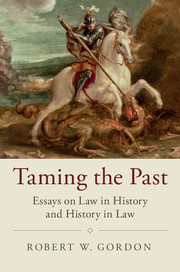Part I - The Common Law Tradition in Legal Historiography
Published online by Cambridge University Press: 13 July 2017
Summary
[This essay first appeared in 10 Law & Society Review 9 (1975), as the first part of an introduction to a Festschrift for the Wisconsin social-legal historian James Willard Hurst. Its aim was to sketch the history of American legal historiography before Hurst came on the scene and to explain how Hurst broke with the tradition of largely “internal” legal history. (In this collection, the essay is split into two parts, with the second part on Hurst’s contributions – “James Willard Hurst – Social Legal History’s Pioneer” – in the section on “Legal Historians” that follows this one.) Since this was written several notable works have amplified and added much valuable detail to the account given here – most especially of legal history-writing in the nineteenth century: John Burrow, A Liberal Descent: Victorian Historians and the English Past (1981); Stephen Siegel, “Historism in Late Nineteenth Century Constitutional Thought,” 1990 Wis. L. Rev. 1431; Kunal Parker, Common Law, History and Democracy in America, 1790–1900: Legal Thought Before Modernism (2011); and David M. Rabban, Law’s History: American Legal Thought and the Transatlantic Turn to History (2012).]
- Type
- Chapter
- Information
- Taming the PastEssays on Law in History and History in Law, pp. 15 - 74Publisher: Cambridge University PressPrint publication year: 2017

